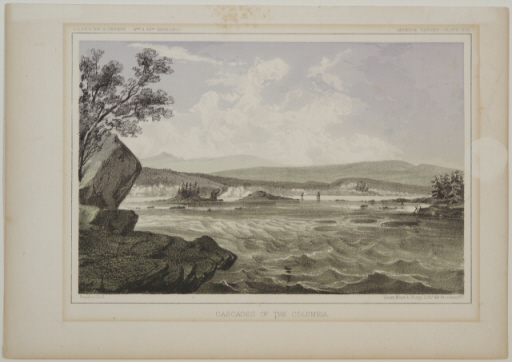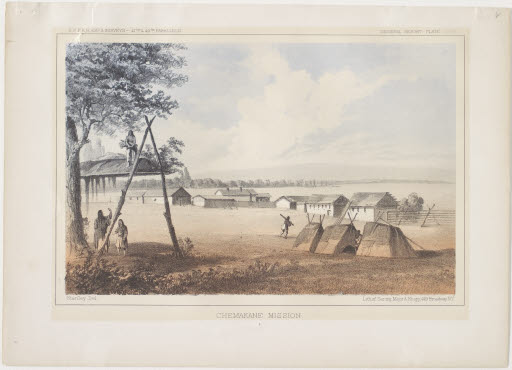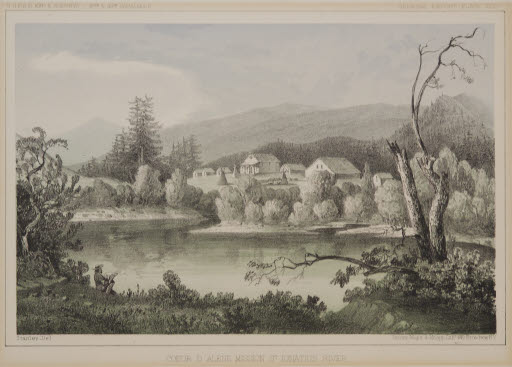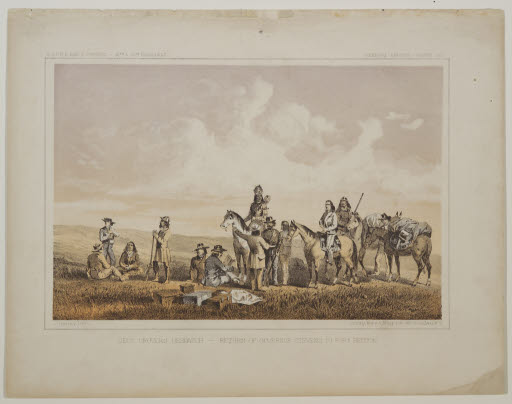John Mix Stanley
1814–1874
Nationality: American
Affiliations: Indian Painter, Survey Artist, Official artist for the Isacc I. Stevens exhibition, and 1853
John Mix Stanley was born in Canandaigua, New York in 1814 and died in Detroit, Michigan in 1872. He became an important Indian painter and survey artist.
Orphaned in 1828, Stanley was apprenticed to a coach maker. He moved to Detroit and became a painter of houses and signs in 1834. There, James Bowman, an accomplished portrait painter, admired a Stanley sign and took Stanley as a pupil. Stanley painted portraits around Chicago from 1836 to 1838. In 1842 Stanley established a studio in Fort Gibson, Oklahoma, painting frontiersmen and Indians. By 1846, Stanley’s paintings of Indians were on display in Cincinnati. Stanley joined a wagon train for Santa Fe that year where he became the artist of the Kearny military expedition. Kearny’s official report contained lithographs of Stanley sketches.
He was painting Indian portraits in Oregon in 1847 and Polynesian portraits in Hawaii in 1848–1849. Stanley displayed his Indian Gallery in Eastern cities in 1850–1851 and, in 1852, placed his collection of 150 paintings on display at the Smithsonian Institution. He offered it to the United States Government for $19,200. Congress refused, and, unfortunately, the collection was destroyed by fire in 1865.
In 1853, Stanley became the official artist for the Isaac I. Stevens expedition for the northern railway survey and a year later he used his field sketches to prepare a huge panorama of 42 episodes of Western scenes. Like most of Stanley’s original work, the panorama has disappeared.
Stanley married in 1854. The remainder of his life was spent as a studio artist and arranging for chromolithography of his paintings.
Sources: Who’s Who in American Art.

Cascades of the Columbia
Date: c. 1853
Image Dimensions: 6 1/4 x 9 1/8 inches (image)
Medium: Lithograph
Inscription: “CASCADES OF THE COLUMBIA,” bottom center margin; “U.S.P.R.R. Exp. & Surveys 47th & 49th Parallels,” upper left; “General Report - Plate XLV,” upper right; “Stanley del.,” lower left; “Sarony, Major & Knapp Liths 449 Broadway N.Y.,” lower right.
Subjects: Columbia River and landscape
Provenance: Eastern Washington State Historical Society, 1987
Collection Number: 3250.1

Chemakane Mission
Date: ca. 1853
Image Dimensions: 6 3/4 x 9 1/2 inches (image)
Medium: Lithograph
Inscription: “Plate XXXIX,” upper right; “Lith. of Sarony, Major & Knapp 449 Broadway, NY,” lower right; “Stanley, Del,” lower right; “VSPRR EXP & Surveys 47th and 49th parallels,” upper right
Curator Notes: American explorers Lewis and Clarke first noted Salishan speaking American Indian people, now known as the Spokan, living along the Spokane River in Eastern Washington in 1805. In 1839, Presbyterian missionaries established a mission among the Lower Spokan people at Chemakane, Washington. There they published a Spokan language primer in 1842, one of the earliest books printed on the Pacific coast. John Mix Stanley documented the mission buildings during the Northern Pacific Railway survey expedition of 1853. Missionaries abandoned the mission in 1849 following the massacre of Reverend Marcus Whitman and his companions at the Waiilatpu Presbyterian mission in the Walla Walla valley.
Subjects: Chemakane Mission and landscape
Provenance: Gift of Mrs. John Odson, 1938
Collection Number: 919.2

Coeur d’Alene Mission, St. Ignatious River
Date: c. 1853
Image Dimensions: 6 1/4 x 9 1/4 inches (image)
Medium: Lithograph
Inscription: “Plate XXXV U.S.P.R.R. Exp. & Surveys 47th and 49th Parallels,” upper left; “Sarony, Major & Knapp Lith,” upper right; “449 Broadway NY,” lower right; “Stanley, Del,” lower left
Subjects: Coeur d’Alene Mission, St. Ignatious River, and landscape
Provenance: Eastern Washington State Historical Society, 1978
Collection Number: 2496.2

Falls of the Spokane
Date: c. 1853
Image Dimensions: 6 3/4 x 9 1/2 inches (image)
Medium: Lithograph
Inscription: “U.S.P.R.R. Exp. & Surveys 47th and 49th Parallels. Sarcony, Major & Knapp Lith. 449 Broadway NY,” lower right; “Stanley, Del,” lower left
Subjects: Spokane Falls and landscape
Provenance: Eastern Washington State Historical Society, 1978
Collection Number: 2496.1

Hudson Bay Mill
Date: ca. 1853
Image Dimensions: 6 3/16 x 9 5/16 inches (image)
Medium: Lithograph
Inscription: “Plate XXXVII,” upper right corner; "“Sarony, Major & Knapp Lith.449 Broadway, NY,” lower right corner; "“Stanley, Del,” lower left corner; “VSPRR Exp & Surveys,” upper left corner
Curator Notes: In 1853, John Mix Stanley, join the Isaac Stevens survey expedition for the Northern Pacific Railway as the expedition’s official artist. He sketched wild life, people and landscape views and participated in the preliminary survey report delivered in Washington DC.Although much of Stanley’s original works are lost his views of the West survive as published images like this lithograph of the Hudson Bay Mill.
Subjects: building, Hudson Bay, landscape, and mill
Provenance: Gift of Mrs. John Odson, 1938
Collection Number: 919.1

Lieut. Crovers Despatch—Return of Governor Stevens to Fort Benton
Date: c. 1853
Image Dimensions: 6 1/8 x 9 /14 inches (image)
Medium: Lithograph
Inscription: “U. S. P. R. R. Exp. and Surveys 47th and 49th Parallels,” upper left; “General Report - Plate XXV,” upper right; “Stanlay, Del.,” lower left; “arony, Major & Knapp Liths 449 Broadway NY,” lower right
Subjects: military, fort, Isaac Stevens, landscape, government, Fort Benton, building, and Army
Provenance: Gift of Mr. Waldo Emerson Rosebush, 1955
Collection Number: 1564.75